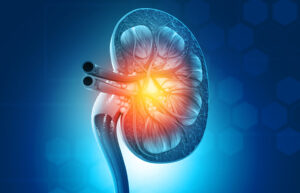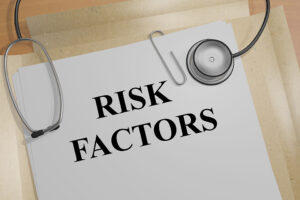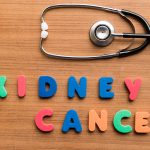Kidney Cancer
Kidney cancer (also called renal cancer) affects the kidneys—two bean-shaped organs located in the mid-to-upper back, with one kidney on either side of the spine.

The kidneys have several important jobs. They filter blood and remove waste to form urine, which is eventually stored in the bladder until a person urinates. The kidneys also make hormones. One is called renin, and it helps control blood pressure. Another is erythropoietin, which helps bone marrow make red blood cells.
Cancer occurs when changes in certain cells cause them to accumulate and form tumors. People with kidney cancer may have one or more tumors in one kidney. It’s also possible to have tumors in both kidneys at the same time.
Types of kidney cancer
There are several types of kidney cancer, and treatment decisions are often made based on the type of cancer.
There are several types of kidney cancer, and treatment decisions are often made based on the type of cancer.
Renal cell carcinoma (RCC)
Renal cell carcinoma (RCC) is by far the most common type, affecting about 90% of kidney cancer patients, according to the American Cancer Society. RCC begins in the lining of renal tubules, part of the filtering system.
RCC is classified into several subtypes:
- Clear cell renal cell carcinoma (ccRCC). Also called conventional renal cell carcinoma or renal cortical tumors, these cancer cells look clear when viewed under a microscope. The American Cancer Society estimates that 70% of people with RCC have this subtype.
- Papillary renal cell carcinoma (PRCC). Papillary RCC tumors have papillae—small bumps that stick out. About 10% of people with RCCs have this subtype, according to the American Cancer Society. PRCC has two types. Type 1 develops slowly while type 2 is more aggressive.
- Chromophobe renal cell carcinoma. This type accounts for about 5% of RCC cases, according to the American Cancer Society. The cells are pale, but larger than clear cells that form ccRCC tumors. In some cases, this type is less aggressive than other types.
- Rare types of RCC. The American Cancer Society reports that these RCC subtypes affect less than 1% of people with RCC:
- Collecting duct RCC
- Multilocular cystic RCC
- Medullary carcinoma
- Mucinous tubular and spindle cell carcinoma
- Neuroblastoma-related RCC
- Unclassified renal cell carcinoma (unclassified RCC). Not all kidney cancer cells fall into a specific category. It’s also possible to have more than one type of cancer cell in a tumor. Scientists call this type unclassified renal cell carcinoma.
Other types of kidney cancer
Transitional cell carcinoma (TCC). This type of kidney cancer starts in the lining (transitional cells) of the renal pelvis, the area where urine accumulates before traveling down the ureter to the bladder. The cells look and act differently from RCC cells; they are actually similar to bladder cancer cells. TCC is also called urothelial carcinoma and upper tract urothelial tumors.
Wilms tumor. Wilms tumors are more common in children than in adults. This type of cancer is also called nephroblastoma.
Renal sarcoma. This rare type of kidney cancer starts in the blood vessels or connective tissue. It is considered soft tissue sarcoma.
Benign kidney tumors
Benign tumors are not cancerous. These types of tumors don’t spread to other organs, but they can still grow. They are often treated in ways similar to kidney cancer. (Read more about kidney cancer treatment below.)
- Angiomyolipoma. These tumors are more frequent in women and in people with tuberous sclerosis, a rare genetic disorder. They can become large and affect nearby tissues. Common symptoms are pain and internal bleeding.
- Oncocytomas. Men are more likely to develop oncocytomas than women are. These tumors can become quite large and are usually removed surgically.
Risk factors for kidney cancer

Scientists don’t know exactly what causes kidney cancer, but they have identified several factors that can raise a person’s risk:
- Older age. Kidney cancer is more common in people older than 50.
- Being male. Compared to women, men are twice as likely to develop kidney cancer.
- Race. Kidney cancer is more common in African Americans.
- Family history. The risk is higher if a person’s sibling or parent has had kidney cancer.
- Smoking. Smoking is a huge risk factor for kidney cancer. And the more a person smokes—both quantity and length of time—the higher the risk.
- Obesity. Scientists think the link between obesity and kidney cancer could be hormone-related.
- High blood pressure (hypertension). Experts have identified high blood pressure as a risk factor, but they are still investigating the reasons for this connection.
- Advanced kidney disease/being on dialysis. Kidney cancer risk is higher for people on long-term dialysis. (Dialysis is a procedure that filters wastes out of the blood when the kidneys cannot do it on their own.)
- Medications. Drugs like acetaminophen and phenacetin have been linked to kidney cancer. Immunosuppressant drugs (which transplant patients take so their body won’t reject a new organ) may also raise risk.
- Exposure to toxins. People who use or work with trichloroethylene, cadmium, and asbestos could be at higher risk.
- Rare inherited diseases. People with these genetic diseases are more likely to be diagnosed with kidney cancer, especially at younger ages:
- Von Hippel-Lindau disease
- Birt-Hogge-Dube syndrome
- Hereditary papillary renal cell carcinoma
- Hereditary leiomyoma-renal cell carcinoma
- Familial renal cancer
- Cowden syndrome
- Tuberous sclerosis
Note: Having a risk factor doesn’t mean a person will get kidney cancer. And people without risk factors can also get kidney cancer.
Symptoms of kidney cancer
Kidney cancer doesn’t always have symptoms, especially in the early stages.
Kidney cancer doesn’t always have symptoms, especially in the early stages. In fact, many people find out they have kidney cancer when they’re having tests for other health problems. In some cases, the cancer isn’t found until it’s fairly advanced.
When symptoms do occur, they may include the following:

- Blood in the urine (hematuria)
- Low back pain, usually on one side
- Lump on the lower back or the side (near the waist)
- Poor appetite
- Unusual weight loss
- Fever that doesn’t get better
- Night sweats
- Fatigue
- Anemia
- Swelling around the left testicle
Symptoms of kidney cancer can be similar to those of other health problems, such as a urinary tract infection or kidney stones. So it’s important to have a checkup with a doctor.
Kidney cancer diagnosis
Doctors use several exams and tests to diagnose kidney cancer and to monitor a patient’s progress:
Medical history. The first step is taking a medical history. The doctor will ask questions about overall health, specific symptoms, family history, and any risk factors.
Physical exam. During a physical exam, the doctor will check for any unusual lumps or masses.
Blood tests:
- Comprehensive metabolic panel. This test checks a variety of substances in the blood, including glucose (sugar), calcium, and sodium. It also checks levels of blood area nitrogen (BUN) and creatinine, which may provide clues about a patient’s kidney function.
- Complete blood count. Anemia (when there are too few red blood cells) is common in people with kidney cancer. It’s also possible to have polycythemia (too many red blood cells).
- Blood chemistry test. High levels of liver enzymes and blood calcium could suggest kidney cancer.
Urinalysis. This is the testing of a urine sample. Blood in the urine might suggest kidney cancer.
Urine cytology. Using a microscope, a specialist checks a urine sample for cancer cells.
Imaging tests. These tests give doctors a better look at the kidneys and surrounding tissues. Testing might include:
- Computed tomography (CT) scan. Using X-ray technology, a CT scan can show the location, size, and shape of tumors. It can also reveal whether cancer cells have spread to other parts of the body.
- Magnetic resonance imaging (MRI) scan. This test might be used if a person is unable to have a CT scan. It provides similar information. MRI scans can also show if cancer has spread.
- Angiography. Typically, this x-ray test is done at the same time as a CT scan or MRI scan. Doctors use it to determine which blood vessels are feeding the kidney tumor(s).
- Ultrasound. These images are created with sound waves. They can show whether a tumor is solid or filled with fluid. A solid tumor is more likely to be cancerous, and a fluid-filled tumor is more likely to be benign (not cancerous).
- Other imaging tests. Doctors may order a chest x-ray or bone scan to see if cancer has spread to the lungs or bones.
Biopsy. During a biopsy, a surgeon removes a small sample of kidney tissue, which is then analyzed under a microscope. However, a biopsy is not always needed to diagnose kidney cancer.
Kidney cancer treatment
Surgery
Patients with localized kidney cancer usually have surgery to remove either all or part of the affected kidney. In some cases, surgery can cure the cancer.
The following procedures may be done openly (with a long incision), laparoscopically (with smaller incisions and a video camera), or robotically (with instruments held by a surgeon-operated robot).
Radical nephrectomy
With this procedure, the surgeon removes the entire kidney. Nearby adrenal glands, lymph nodes, and other tissues may be removed if necessary. This approach is typically done if a person has a large tumor or several small ones.
Following radical nephrectomy, a patient has only one kidney. For most people, this isn’t an issue, as long as the remaining kidney is healthy.
Partial nephrectomy
With a partial nephrectomy, surgeons remove only the portion of the kidney that is affected by the tumor. The rest of the kidney remains. This is sometimes called a nephron-sparing approach. Nephrons are filters that remove waste from the blood.
Surgery might also be done to remove cancer cells if the cancer has spread beyond the kidney.
Other treatments
Some people may not be well enough for surgery or may decide that surgery is not the best choice for them. In these cases, other approaches might be considered:
Radiofrequency ablation. This technique uses radio waves to heat up the tumor. Cancer cells are destroyed by burning them.
Cryoablation. Cancer cells are destroyed by freezing them.
Radiation. Kidney cancer patients unable to have surgery may undergo external beam radiation therapy. External in this case means the radiation comes from a device outside the body. The goal of this approach is usually to relieve cancer symptoms, not necessarily to cure the cancer.
Active surveillance. Small or slow-growing tumors might not need treatment right away. With active surveillance, doctors monitor the cancer and start treatment when necessary.
Immunotherapy. This approach uses special drugs, along with the person’s own immune system, as cancer-fighting tools. Drugs may be given on their own or in combination with other drugs. Immunotherapy is often used for people with advanced cancer or recurrent cancer (cancer that has come back).
Examples of immunotherapy drugs include the following:
- Avelumab
- Interferon-alfa
- Interleukin-2
- Ipilimumab
- Nivolumab
- Pembrolizumab
Targeted therapy. This approach uses drugs that slow down cancer cell
growth. The drugs may be given by mouth or through an IV. Targeted therapy is often used in cases of advanced and recurrent cancers.
Here are some examples:
- Axitinib
- Belzutifan
- Bevacizumab
- Cabozantinib
- Everolimus
- Lenvatinib
- Pazopanib
- Sorafenib
- Sunitinib
- Tivozanib
- Tremsirolimus
What about chemotherapy for kidney cancer?
Chemotherapy uses drugs that reach the whole body. However, it does not always work well for kidney cancer, so it is not commonly used. It might be considered if targeted therapy or immunotherapy are not helpful.
Counseling
Cancer is an emotional journey. People with cancer often cope with anxiety, fear of the unknown, and unexpected lifestyle changes. They may feel anxious, frightened, and angry. For these reasons, finding emotional support is an important part of treatment. This support may be found from family and friends, clergy, or mental health professionals.
Some patients join support groups of fellow patients or survivors. Group members share information, encouragement, and guidance.
After treatment
Patients should have regular follow-up appointments with their cancer care team. It is essential to monitor kidney function through physical exams, lab tests, and imaging tests.
Resources
American Cancer Society
“Kidney Cancer”
https://www.cancer.org/cancer/kidney-cancer.html
“What Are Wilms Tumors?”
(Last revised: October 17, 2018)
https://www.cancer.org/cancer/wilms-tumor/about/what-is-wilms-tumor.html
American Urological Association
Campbell, Steven, MD, PhD, et al.
“Renal Mass and Localized Renal Cancer: Evaluation, Management, and Follow Up”
(Parts I and II – 2021)
https://www.auanet.org/guidelines/guidelines/renal-mass-and-localized-renal-cancer-evaluation-management-and-follow-up
Canadian Cancer Society
”Risk factors for kidney cancer”
https://cancer.ca/en/cancer-information/cancer-types/kidney/risks
Medline Plus
“Comprehensive Metabolic Panel (CMP)”
(Last updated: September 9, 2021)
https://medlineplus.gov/lab-tests/comprehensive-metabolic-panel-cmp/
Memorial Sloan Kettering Cancer Center
“Kidney Cancer Types”
https://www.mskcc.org/cancer-care/types/kidney/types
National Cancer Institute
“Asbestos”
(Updated: December 5, 2022)
https://www.cancer.gov/about-cancer/causes-prevention/risk/substances/asbestos
“Cadmium”
(Reviewed: December 5, 2022)
https://www.cancer.gov/about-cancer/causes-prevention/risk/substances/cadmium
“Trichloroethylene (TCE)”
(Posted: December 8, 2022)
https://www.cancer.gov/about-cancer/causes-prevention/risk/substances/trichloroethylene
National Institute of Diabetes and Digestive and Kidney Diseases
“Your Kidneys & How They Work”
(Last reviewed: June 2018)
https://www.niddk.nih.gov/health-information/kidney-disease/kidneys-how-they-work
National Kidney Foundation
“Kidney Cancer”
https://www.kidney.org/atoz/content/kidney-cancer
UpToDate
Atkins, Michael B., MD
“Patient education: Renal cell carcinoma (kidney cancer) (Beyond the Basics)”
(Topic last updated: August 8, 2022)
https://www.uptodate.com/contents/renal-cell-carcinoma-kidney-cancer-beyond-the-basics

